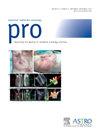与标准疗法相比,"SAVE "试验为早期子宫内膜癌患者提供的短程阴道袖带近距离治疗可改善经济效益。
IF 3.4
3区 医学
Q2 ONCOLOGY
引用次数: 0
摘要
目的:早期子宫内膜癌通常采用子宫切除术,然后进行阴道袖带近距离辅助治疗(VCB)。癌症治疗的经济毒性会影响治疗的完成。早期子宫内膜癌的短程阴道袖带近距离辅助治疗与标准治疗相比试验是一项多中心、前瞻性的随机试验,将医生决定的标准治疗(SoC)VCB 剂量分为 3 至 5 个疗程与 2 个疗程进行比较。我们报告了次要成本终点,量化了缩短疗程对医疗机构和参与患者的经济影响:前瞻性地收集了技术费用(TechCs)、专业费用和总费用(TotCs),并以每位患者的原始费用和医疗保险调整后费用的形式进行报告。对每位患者所在邮政编码的治疗中心距离和收入中位数进行了估算。采用 Mann-Whitney U 统计、t 检验和 X2 检验来比较两组患者的特征:结果:分析了 108 名患者。54 位患者中分别有 27 位(50%)、11 位(20%)和 16 位(30%)的 SoC VCB 分 3、4 和 5 次进行。SoC与实验臂相比,每位患者的总路程中位数分别为213英里和137英里(P = .12),患者的通勤成本中位数分别为36.3美元和18.0美元(P = .11)。与 2 分段治疗相比,5 分段治疗导致旅行距离延长(中位数为 462 英里对 137 英里;p < .01),旅行成本增加(中位数为 59.3 美元对 18.0 美元;p ≤ .01)。以美元计算的每位患者未经调整的原始专业费用在SoC组和实验组之间没有差异(9159美元 vs 7532美元;p = .19)。SoC治疗组的TechCs明显更高(35734美元 vs 24696美元;p≤.01),TotCs也更高(44892美元 vs 32228美元;p <.01;)。SoC治疗组的医疗保险调整后TechCs和TotCs更高:结论:与SoC相比,两分次VCB可减少每位患者的治疗次数,与长疗程相比可降低差旅费用,调整后的医疗支出也有所减少。本文章由计算机程序翻译,如有差异,请以英文原文为准。
Financial Improvements From Short Course Adjuvant Vaginal Cuff Brachytherapy in Early Endometrial Cancer Compared With Standard of Care, “SAVE” Trial
Purpose
Early-stage endometrial cancer is often treated with hysterectomy followed by adjuvant vaginal cuff brachytherapy (VCB). Financial toxicity from cancer treatment can impact treatment completion. The Short Course Adjuvant Vaginal Cuff Brachytherapy in Early Endometrial Cancer Compared to Standard of Care trial is a multicenter, prospective randomized trial of standard of care (SoC) VCB doses delivered in 3 to 5 fractions per the physician's discretion compared with a 2-fraction course. We report on secondary cost endpoints, quantifying the financial impacts of shorter treatment courses on institutions and participating patients.
Methods and Materials
Technical (TechCs), professional, and total charges (TotCs) were collected prospectively and are reported as raw and Medicare-adjusted charges per patient. Distance to the treatment center and the median income for each patient's zip code were estimated. The Mann-Whitney U statistic, t test, and X2 test were used to compare characteristics between the 2 groups.
Results
One hundred eight patients were analyzed. SoC VCB was delivered in 3, 4, and 5 fractions for 27 of 54 patients (50%), 11 of 54 (20%), and 16 of 54 (30%), respectively. The median total distance traveled per patient for SoC versus experimental arms was 213 versus 137 miles (p = .12), and the median cost of commute for patients was $36.3 versus $18.0 (p = .11). Compared with 2-fraction treatment, 5-fraction treatment resulted in longer travel distances (median, 462 vs 137 miles; p < .01) and increased travel costs (median, $59.3 vs $18.0; p ≤ .01). Unadjusted raw professional charges in USD per patient did not differ between SoC versus experimental arms ($9159 vs $7532; p = .19). TechCs were significantly higher in the SoC arm ($35,734 vs $24,696; p ≤ .01), as were TotCs ($44,892 vs $32,228; p < .01;). Medicare-adjusted TechCs and TotCs were higher for the SoC arm.
Conclusions
Two-fraction VCB resulted in fewer treatments per patient, reduced cost of travel compared with longer courses, and an adjusted reduction in health care expenditures compared with SoC.
求助全文
通过发布文献求助,成功后即可免费获取论文全文。
去求助
来源期刊

Practical Radiation Oncology
Medicine-Radiology, Nuclear Medicine and Imaging
CiteScore
5.20
自引率
6.10%
发文量
177
审稿时长
34 days
期刊介绍:
The overarching mission of Practical Radiation Oncology is to improve the quality of radiation oncology practice. PRO''s purpose is to document the state of current practice, providing background for those in training and continuing education for practitioners, through discussion and illustration of new techniques, evaluation of current practices, and publication of case reports. PRO strives to provide its readers content that emphasizes knowledge "with a purpose." The content of PRO includes:
Original articles focusing on patient safety, quality measurement, or quality improvement initiatives
Original articles focusing on imaging, contouring, target delineation, simulation, treatment planning, immobilization, organ motion, and other practical issues
ASTRO guidelines, position papers, and consensus statements
Essays that highlight enriching personal experiences in caring for cancer patients and their families.
 求助内容:
求助内容: 应助结果提醒方式:
应助结果提醒方式:


